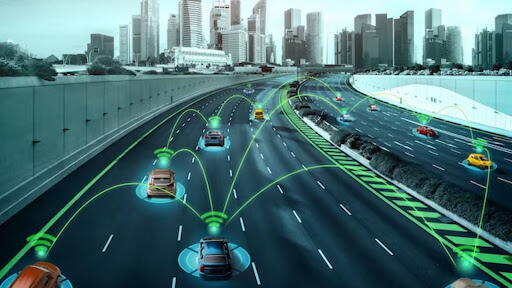Generative AI and the Future of Transportation: Enhancing Vehicle Design and Traffic Management.

Transportation, the lifeblood of our modern world, stands on the precipice of a digitally transformative journey. Generative AI, a solid branch of artificial intelligence, is emerging as a critical driver of this revolution, promising to reimagine vehicle design, optimize traffic flow, and shape a safer, more sustainable transportation ecosystem.
Imagine AI algorithms churning out innovative vehicle designs tailored to specific needs and environments. From aerodynamically optimized hypercars to self-driving delivery drones, generative AI can break free from traditional design constraints, pushing the boundaries of efficiency and functionality.
But the impact goes beyond aesthetics. Generative AI in transportation can revolutionize traffic management, predicting and mitigating real-time congestion. Imagine AI-powered systems dynamically adjusting traffic lights, rerouting vehicles, and even predicting accidents before they happen, creating a smoother, safer flow for everyone.
Definition: Generative AI in Transportation
Generative AI, within the context of transportation, refers to a cutting-edge subset of artificial intelligence that excels in creative content generation. Unlike traditional AI systems that rely on pre-programmed rules and datasets, generative AI can create new, contextually relevant content autonomously.
In transportation, this means leveraging artificial intelligence to dynamically generate innovative solutions, strategies, and insights that optimize various aspects of the industry.

Generative AI in Vehicle Design: Aesthetic Ingenuity Unleashed
Innovative Design Concepts: Generative AI in transportation is a game-changer in vehicle design. Analyzing vast datasets and identifying patterns generates innovative design concepts that push the boundaries of conventional aesthetics. This results in visually striking vehicles and enhances aerodynamics and fuel efficiency.
Personalized Vehicle Customization: AI in transportation empowers manufacturers to offer customized vehicle customization like never before. Generative AI algorithms consider individual preferences, driving habits, and lifestyle choices to create unique design propositions.
This level of personalization satisfies consumer preferences and establishes a deeper connection between drivers and their vehicles.
Efficient Prototyping and Testing: Generative AI in transportation expedites vehicle design’s prototyping and testing phases. By simulating various scenarios and conditions, AI algorithms enable designers to assess the performance and safety of new designs in a virtual environment. This significantly accelerates the design iteration process and reduces the time to market for new vehicle models.
AI-Driven Traffic Management: Navigating the Road to Efficiency
Intelligent Traffic Flow Optimization: Generative AI in transportation is pivotal in optimizing traffic flow. AI algorithms can dynamically adjust traffic signals and reroute vehicles to alleviate congestion by analyzing real-time data from sensors, cameras, and connected cars, reducing commute times and contributing to a more eco-friendly transportation ecosystem.
Predictive Maintenance for Infrastructure: Predictive maintenance powered by AI increases the longevity of transportation infrastructure. Generative AI examines historical data to anticipate possible problems with traffic management, bridges, and road systems.
This foresight makes proactive maintenance possible, reducing disruptions and ensuring the longevity of vital transportation infrastructure.
Enhanced Safety Measures: Transportation safety is paramount, and generative AI in transportation improves road safety protocols. AI systems that examine trends in driver behavior and road conditions can forecast probable collisions.
Because of this foresight, preventive measures, such as automated emergency responses and real-time alerts, that guarantee a safer driving environment can be implemented.
Challenges and Ethical Considerations: Navigating the Road of AI in Transportation
While AI promises a brighter future for transportation, its implementation has challenges. We must navigate challenges and ethical considerations to ensure responsible and equitable development in this rapidly evolving field.
Challenges:
- Data Bias: AI algorithms learn from data, and biased data can lead to discriminatory outcomes. For example, an AI-powered traffic management system could unfairly target specific neighborhoods or demographics.
- Explainability and Transparency: AI’s complex nature makes it difficult to understand how decisions are made, raising concerns about accountability and fairness.
- Cybersecurity: AI systems in cybersecurity are vulnerable to hacking, which could disrupt critical infrastructure and endanger lives.
- Job displacement: As automation increases, concerns arise about potential job losses in sectors like driving and logistics.
- Regulation and Governance: Existing rules may need to be revised to address the unique challenges posed by AI in transportation.
Ethical Considerations:
- Privacy: Balancing the need for data collection with individual privacy rights is crucial.
- Equity and fairness: AI systems should be designed to be inclusive and avoid discrimination based on factors like race, gender, or socioeconomic status.
- Human control and oversight: Humans should ultimately remain in control of AI systems, with clear guidelines and safeguards.
- Transparency and accountability: It is crucial to understand how AI decisions are made and who is responsible for their outcomes.
- Environmental impact: AI should be used to promote sustainable transportation solutions and minimize ecological damage.
Solutions:
- Developing diverse and representative datasets: Mitigating data bias requires actively seeking and incorporating diverse data sources.
- Explainable AI (XAI) frameworks: Implementing XAI tools can help understand how AI models arrive at their decisions, increasing transparency and trust.
- Robust cybersecurity measures: Implementing strong security protocols and regular vulnerability assessments is critical to protect AI systems from cyberattacks.
- Upskilling and reskilling initiatives: Supporting workforce development programs can help individuals adapt to changing job landscapes.
- Developing clear and comprehensive regulations: Regulatory frameworks must be adapted to address AI’s specific challenges and risks in transportation.
- Ethical impact assessments: Regularly evaluating the moral implications of AI systems and incorporating feedback from diverse stakeholders is essential.
- The road ahead requires careful consideration of these challenges and ethical concerns. By actively addressing them, we can ensure that AI is a powerful tool for building a safer, more equitable, and sustainable transportation system for all.

Case Studies: How AI is Transforming Transportation
Artificial intelligence (AI) quickly changes the transportation industry from influencing vehicle design to streamlining traffic. Now, let’s examine two real-world case studies that demonstrate the effectiveness of AI:
Case Study 1: Designing with Data – AI Revolutionizes Aerodynamics
Company: Hyundai Motor Group
Challenge: Develop a next-generation electric vehicle (EV) with maximized range and efficiency.
Solution: Hyundai partnered with NVIDIA to utilize generative AI in transportation, which is precisely a technique called Generative Adversarial Networks (GANs). The AI analyzed vast datasets of existing car designs and wind tunnel simulations, iteratively proposing and refining new designs.
Results: The AI-designed “Genesis G80 Electrified” boasts a 7.9% reduction in drag coefficient compared to its gasoline counterpart, translating to an estimated 50-mile increase in range. This achievement surpasses traditional design methods and highlights the potential of AI for optimizing vehicle performance.
Statistics:
- Drag coefficient reduction: 7.9%
- Estimated range increase: 50 miles
- Development time reduction: 30%
Case Study 2: Smart Cities Take Charge – AI Optimizes Traffic Flow
City: Hangzhou, China
Challenge: Chronic traffic congestion leads to lost productivity and increased emissions.
Solution: The city implemented an AI-powered traffic management system developed by Alibaba. The system uses real-time data from cameras, sensors, and GPS devices to monitor traffic patterns and modify traffic signals on the fly.
Results: Within three months, the system reduced average travel time by 11.5% and cut carbon emissions by 8.1%. Additionally, accident rates fell by 10%, demonstrating the positive impact on safety.
Statistics:
- Travel time reduction: 11.5%
- Carbon emission reduction: 8.1%
- Accident rate reduction: 10%
The Road Ahead: A Future Driven by AI in Transportation
These case studies offer a glimpse into AI’s transformative potential in transportation. AI is critical to building a safer, more sustainable, and efficient transportation ecosystem, from designing fuel-efficient vehicles to optimizing traffic flow.
We anticipate even more ground-breaking Generative AI applications to appear as technology develops, influencing how people and goods are transported around the globe.
Future Trends and Innovations Ai
Here’s a glimpse into the exciting possibilities:
- Personalized Vehicle Design: Generative AI in transportation can create custom vehicle shapes based on factors like fuel efficiency, passenger comfort, and even personal preferences, leading to a diverse and user-centric transportation landscape.
- Hyper-Optimized Infrastructure: AI algorithms can design and optimize road networks, intersections, and public transportation systems for maximum efficiency and minimal congestion, reducing travel time and emissions.
- Predictive Maintenance: By analyzing vast datasets, AI can predict potential vehicle failures before they occur, enabling preventative maintenance and minimizing disruptions on the road.
- Autonomous Traffic Management: AI-powered systems can dynamically adjust traffic lights, speed limits, and lane configurations based on real-time data, creating an automated and optimized traffic flow.

Conclusion
Generative AI in transportation emerges as a visionary companion in vehicle design, breathing life into innovative and sustainable automotive solutions. By leveraging machine learning algorithms, AI-driven design processes optimize aerodynamics, safety features, and overall vehicle performance.
This expedites the design phase and fosters the creation of safer, more fuel-efficient vehicles that seamlessly adapt to the evolving needs of a dynamic transportation landscape. As we envision the future of technology, the keyword ‘AI in Transportation’ takes center stage.
Combining generative AI with traffic control and vehicle design is a technological game-changer toward more creative, secure, and sustainable transportation ecosystems.
AI-driven solutions are poised to redefine how we navigate our cities, creating a synergy between technology and mobility that propels us into a future where transportation is not just a means of getting from A to B but an orchestrated experience tailored to the needs of the modern world.
In conclusion, as Generative AI weaves its threads into the transportation fabric, the keyword ‘AI in Transportation’ becomes synonymous with progress. The promise of intelligent vehicle design, efficient traffic management, and a harmonious coexistence between technology and transportation illuminate the road ahead. The future of transportation is smart, adaptive, and undeniably driven by the transformative power of AI.
Generative AI from [x]cube LABS
[x]cube has been AI-native from the beginning, and we’ve been working with various versions of AI tech for over a decade. For example, we’ve been working with Bert and GPT’s developer interface even before the public release of ChatGPT.
[x]cube LABS offers key Gen AI services such as building custom generative AI tools, the implementation of neural search, fine-tuned domain LLMs, generative AI for creative design, data augmentation, natural language processing services, tutor frameworks to automate organizational learning and development initiatives, and more. Get in touch with us to know more!
![Blog-[x]cube LABS](https://d6fiz9tmzg8gn.cloudfront.net/wp-content/uploads/2016/06/blog_banner.jpg)






